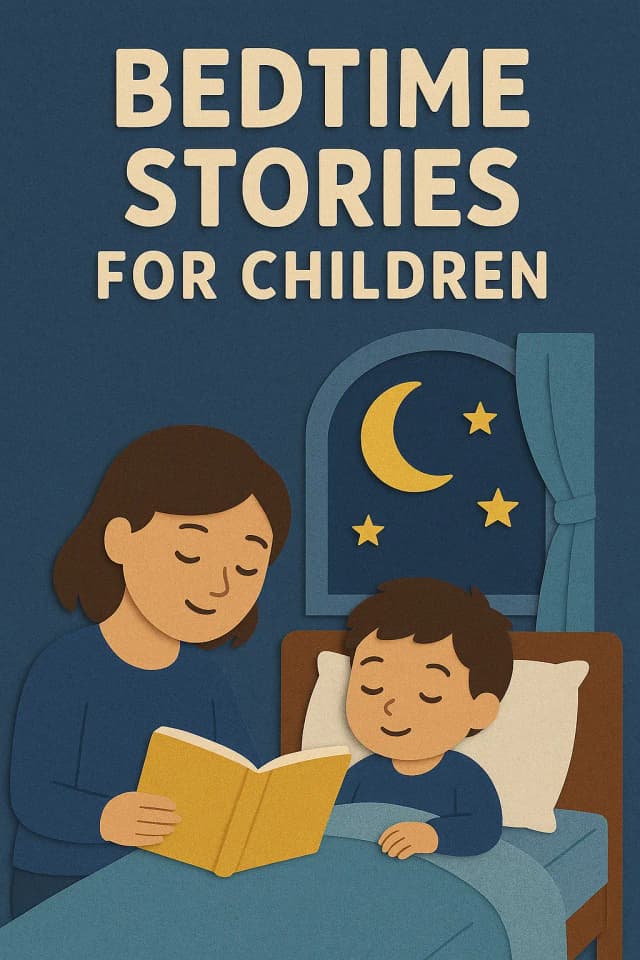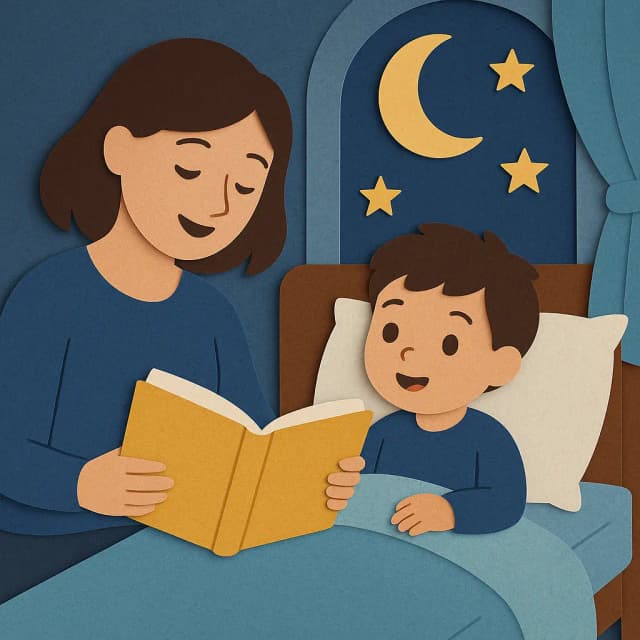The Definitive Parent's Handbook for Bedtime Stories
Those who follow Story Spark will know that we love Bedtime Stories which is a cherished part of parenting. Many of us remember being tucked in with a gentle story at night, and now we find ourselves carrying on that tradition with our own children.
In this comprehensive guide, we’ll explore the what, why, and how of bedtime stories – answering common questions parents have about this nightly ritual. From understanding the benefits for your child’s development and sleep to practical tips on when to start, how long to read, and how to choose the best stories, this article offers research-backed insights and supportive advice to make the most of storytime with your little ones.


What is a bedtime story?
A bedtime story is essentially a story read or told to a child at bedtime as part of the wind-down routine each night. It can be as simple as reading a favorite picture book aloud or narrating an improvised tale while your child lies snug in bed. The key is that it’s a calm, gentle story shared in the moments before sleep. The tradition of bedtime storytelling has a long history – it’s a “traditional form of storytelling, where a story is told to a child at bedtime to prepare the child for sleep”.
In practice, this might mean a parent or caregiver sitting beside the bed and reading quietly from a book, often with soft voices and plenty of cuddles. Bedtime stories are usually short and soothing; they often mirror the quiet atmosphere of night, sometimes even featuring characters going to sleep themselves. The goal is not only to entertain the child but also to help them relax, feel safe, and drift into sleep.
Why are bedtime stories important?
Bedtime stories offer a host of developmental, emotional, and cognitive benefits for children. Far from being “just a nice tradition,” reading to your child at night can profoundly support their growth in multiple ways. In fact, experts emphasize that this simple practice has tangible positive effects on language, literacy, and brain development, while also strengthening the parent-child bond.
Here are some of the key reasons bedtime stories are so important for kids:
Language and cognitive development
Reading aloud exposes children to new words, concepts, and ways of expressing ideas. Nightly storytime has been linked to improved language skills, vocabulary expansion, and even measurable differences in brain activity. For example, a study in the journal Pediatrics found that preschool-aged children who were read to frequently had greater activation in brain areas responsible for mental imagery and narrative comprehension – crucial building blocks for language and literacy. Research has also shown that children who are read to more often have larger vocabularies; one source notes that a child may need to hear a new word up to 12 times before using it, and bedtime stories provide a perfect opportunity for this kind of repetition and exposure.
Love of reading and imagination
Making stories part of the nightly routine helps cultivate a lifelong love of books. When reading is associated with warm, cozy feelings and quality time with a parent, children develop positive attitudes toward reading itself. Over time, this encourages a habit of reading for pleasure – kids who enjoy being read to are more likely to pick up books on their own as they grow. Reading for pleasure has been showed to be one of the biggest contributing factors to life outcomes.
Social and emotional benefits
Bedtime reading is an incredible tool for emotional bonding and social-emotional learning. In our busy lives, bedtime might be the one dedicated calm period when your child has your full attention. Sharing a story creates intimate one-on-one time that strengthens your relationship. Snuggling up with a book sends the child a powerful message of love and security.
Many parents also find that this quiet time opens the door for deeper conversations. Children often ask questions about the story or relate it to their own day, giving you a chance to chat and for them to voice thoughts or worries. Books can be a gentle way to discuss emotions or challenges a child might be facing. Stories often address themes like friendship, fear, or feeling sad, which can help kids realize their feelings are normal and learn how others cope.

“Reading helps children recognize that they are not alone, and that others have faced the same problems and feelings”
theschoolrun.com
Routine and sense of security
Incorporating a book before bed gives structure to a child’s evening and signals that the day is done. Young children, especially, thrive on predictable routines. Knowing that after pajamas and teeth brushing comes storytime and then sleep can make bedtime a calmer, more orderly experience. Consistency is reassuring – the world feels safe and predictable. Psychologist often describe a bedtime story as an “emotional security check-in” for the child.
Behavior and other benefits
Bedtime stories also have some practical perks. Children who are engaged during storytime are less likely to resist bedtime – the story distracts from any urge to stall or protest going to sleep. Instead of “bedtime battles,” you have a child who is looking forward to the next chapter or the next page. Listening to a book can also improve a child’s attention span and listening skills, since they practice sitting still and focusing on the narrative.

Do bedtime stories help kids sleep?
Parents everywhere hope that a bedtime story will eventually lead to a peacefully sleeping child – and there’s good reason for that hope. Yes, bedtime stories really can help kids sleep better. They are a proven way to relax children and signal that it’s time to transition to sleep. Over time, the routine of reading at night becomes a powerful cue in a child’s mind and body that brings on drowsiness. Sleep experts describe it as creating a conditioned response: the child’s brain learns to associate the sound of Mom or Dad’s calm reading voice and the familiar story with the comfort and safety of bedtime, triggering the body’s natural sleep mechanisms.

What age should you start bedtime stories?
Believe it or not, it’s never too early. You can begin reading to your baby from the newborn stage—even if they don’t understand the words yet. In those early days, the sound of your voice becomes a source of comfort, and the act of reading strengthens the parent-child bond.
By six months, babies begin to show interest in pictures and tone of voice. By one year, they’re turning pages and pointing at images. Starting early builds a love for books that can last a lifetime.

Should you read to your child every night?
Ideally, yes. Making storytime a nightly tradition has countless benefits. It sets a consistent bedtime routine, improves literacy skills, and fosters a lifelong love of reading. But more than that, it carves out a special space in the day just for the two of you.
Of course, life happens. If you occasionally skip a night, don’t worry. But the more consistent the practice, the more impactful the results.

How long should you read bedtime stories for?
Multiple organizations have suggested targets for daily reading. For example, the UK charity BookTrust suggests aiming for “10 minutes of reading every day.” In the US, many educators recommend at least 15 minutes per day of reading with your child. This adds up to hours of language exposure each week. However you can adjust this for different ages.
For very young children (babies and toddlers), this might be just one short board book or a few pages of a picture book, which could take 5 minutes. For preschoolers, 10 minutes might cover one or two storybooks. Older children with longer attention spans might enjoy 15–20 minutes or a chapter of a novel.
Don’t forget the goal is to fall asleep! You want them to be pleasantly drowsy by the end, not impatient or overstimulated. Knowing that storytime won’t last forever helps prevent bedtime stall tactics. If a child knows they get two books or 15 minutes (whatever you decide) and then lights out, they’re less likely to keep begging for more endlessly. It’s good to set gentle limits (“We’ll read one more story tonight, then it’s sleep time”) so that the routine stays within a healthy length.

“Generally, five to ten minutes is a good amount of time for younger children, and up to 20 minutes for older children.”
childrenscornergroup.com
What age should you stop bedtime stories?
If bedtime stories are so beneficial, should there come a time when you stop reading to your child at night? There is no strict age at which you must stop bedtime stories – in fact, many experts suggest continuing the tradition for as long as your child is interested, even well into their school years. A common misconception is that once a child learns to read independently (say around 6 or 7 years old), they no longer need a parent to read to them. But children don’t immediately outgrow the benefits of being read to. Even proficient readers still love the experience of sharing a story with a parent, and it continues to pay dividends in learning and bonding.
Research and expert opinion strongly encourage not rushing to end bedtime reading just because a child can read solo. There are specialists who recommend parents continue the bedtime reading tradition even into the teen years!
What makes the best bedtime stories?
The best bedtime stories aren’t necessarily the most exciting or even the most educational. They’re the ones that calm, connect, and capture the imagination. Here’s what to look for:

Gentle, soothing tone: Avoid stories that are too intense or scary right before bed.

Predictable structure: Repetition, rhymes, or familiar patterns can be very comforting.

Relatable characters: Kids love seeing themselves in stories—or meeting lovable creatures who feel like friends.

A touch of wonder: Talking animals, enchanted forests, or whimsical adventures spark curiosity and delight.

Emotional warmth: Stories that end with kindness, safety, or family togetherness help children feel secure as they drift off to sleep.
Some beloved bedtime classics include Goodnight Moon, Guess How Much I Love You, The Gruffalo, and Where the Wild Things Are. But honestly? Your own made-up tales can be just as beloved, especially when they star your child as the hero like you can on with our Bedtime Story Generator.
In essence, the best bedtime stories are calming, comforting, and tailored to your child’s interests and needs. They strike a balance between holding attention and lulling the listener. They leave the child with positive feelings and a quiet mind. Every child is a bit different, so it might take some experimentation to find what types of stories relax your little one the most. Pay attention to their reactions: do they snuggle in and get drowsy when you read a particular book? Do they seem more wound up after another? Use those cues to choose your go-to bedtime library. Classic choices often include gentle rhyming stories, short fairy tales with happy endings, or any book you can read in a slow, melodic way.
Remember, how you read can be as important as what you read. Dimming the lights, using a loving tone, and cuddling up close can make almost any story feel like the “best” story because the child feels your warmth and attention.
Finally, don’t underestimate the power of your presence and consistency. Part of what makes a story special at bedtime is that Mommy or Daddy is sharing it. Whether it’s a timeless classic or a silly made-up tale, the fact that you are there, every night, creating this peaceful moment is what truly makes it the best story in your child’s eyes. By choosing calming content and making storytime a ritual, you’re not just telling a story – you’re giving your child the gift of security, imagination, and a gentle entry into sleep. Happy reading and sweet dreams!
Keep the Story Going
What age should you stop bedtime stories?
If bedtime stories are so beneficial, should there come a time when you stop reading to your child at night? There is no strict age at which you must stop bedtime stories – in fact, many experts suggest continuing the tradition for as long as your child is interested, even well into their school years. A common misconception is that once a child learns to read independently (say around 6 or 7 years old), they no longer need a parent to read to them. But children don’t immediately outgrow the benefits of being read to. Even proficient readers still love the experience of sharing a story with a parent, and it continues to pay dividends in learning and bonding.
Research and expert opinion strongly encourage not rushing to end bedtime reading just because a child can read solo. There are specialists who recommend parents continue the bedtime reading tradition even into the teen years!
What makes the best bedtime stories?
The best bedtime stories aren’t necessarily the most exciting or even the most educational. They’re the ones that calm, connect, and capture the imagination. Here’s what to look for:

Gentle, soothing tone: Avoid stories that are too intense or scary right before bed.

Predictable structure: Repetition, rhymes, or familiar patterns can be very comforting.

Relatable characters: Kids love seeing themselves in stories—or meeting lovable creatures who feel like friends.

A touch of wonder: Talking animals, enchanted forests, or whimsical adventures spark curiosity and delight.

Emotional warmth: Stories that end with kindness, safety, or family togetherness help children feel secure as they drift off to sleep.
Some beloved bedtime classics include Goodnight Moon, Guess How Much I Love You, The Gruffalo, and Where the Wild Things Are. But honestly? Your own made-up tales can be just as beloved, especially when they star your child as the hero like you can on with our Bedtime Story Generator.
In essence, the best bedtime stories are calming, comforting, and tailored to your child’s interests and needs. They strike a balance between holding attention and lulling the listener. They leave the child with positive feelings and a quiet mind. Every child is a bit different, so it might take some experimentation to find what types of stories relax your little one the most. Pay attention to their reactions: do they snuggle in and get drowsy when you read a particular book? Do they seem more wound up after another? Use those cues to choose your go-to bedtime library. Classic choices often include gentle rhyming stories, short fairy tales with happy endings, or any book you can read in a slow, melodic way.
Remember, how you read can be as important as what you read. Dimming the lights, using a loving tone, and cuddling up close can make almost any story feel like the “best” story because the child feels your warmth and attention.
Finally, don’t underestimate the power of your presence and consistency. Part of what makes a story special at bedtime is that Mommy or Daddy is sharing it. Whether it’s a timeless classic or a silly made-up tale, the fact that you are there, every night, creating this peaceful moment is what truly makes it the best story in your child’s eyes. By choosing calming content and making storytime a ritual, you’re not just telling a story – you’re giving your child the gift of security, imagination, and a gentle entry into sleep. Happy reading and sweet dreams!




